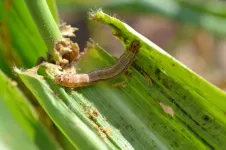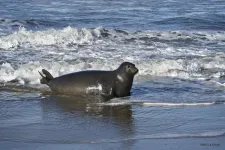(Press-News.org) Exposure to low doses of ionising radiation is associated with a modestly increased excess risk of heart disease, finds an analysis of the latest evidence published by The BMJ today.
The researchers say these findings “have implications for patients who undergo radiation exposure as part of their medical care, as well as policy makers involved in managing radiation risks to radiation workers and the public.”
And a linked editorial suggests that these risks “should now be carefully considered in protection against radiation in medicine and elsewhere.”
It’s well recognised that exposure to high dose radiation can damage the heart, but firm evidence linking low dose radiation to heart disease (eg. scatter radiation dose from radiotherapy or working in the nuclear industry) is less clear.
To address this knowledge gap, an international team of researchers examined scientific databases for studies evaluating links between a range of cardiovascular diseases and exposure to radiation (mostly radiotherapy and occupational exposures).
They excluded uninformative datasets or those largely duplicating others, leaving 93 studies, published mainly during the past decade, suitable for analysis. These studies covered a broad range of doses, brief and prolonged exposures, and evaluated frequency (incidence) and mortality of various types of vascular diseases.
After taking account of other important factors, such as age at exposure, the researchers found consistent evidence for a dose dependent increase in cardiovascular risks across a broad range of radiation doses.
For example, the relative risk per gray (Gy) increased for all cardiovascular disease and for specific types of cardiovascular disease, and there was a higher relative risk per dose unit at lower dose ranges (less than 0.1 Gy), and also for lower dose rates (multiple exposures over hours to years).
At a population level, excess absolute risks ranged from 2.33% per Gy for a current England and Wales population to 3.66% per Gy for Germany, largely reflecting the underlying rates of cardiovascular disease mortality in these populations.
This equates to a modest but significantly increased excess lifetime risk of 2.3-3.9 cardiovascular deaths per 100 persons exposed to one Gy of radiation, explain the authors.
Substantial variation was found between studies, although this was markedly reduced when the authors restricted their analysis to higher quality studies or to those at moderate doses (less than 0.5 Gy) or low dose rates (less than 5 mGy/h).
The authors suggest that mechanisms for these cardiovascular effects are poorly understood, even at high dose.
They also acknowledge that few studies assessed the possible modifying effects of lifestyle and medical risk factors on radiation risk, particularly major modifiable risk factors for cardiovascular disease like smoking, obesity, diabetes, high blood pressure and high cholesterol, and say further research is needed in this area.
In conclusion, they say their findings support an association between acute high dose and (to a lesser extent) chronic low dose radiation exposure and most types of cardiovascular disease and suggest that “radiation detriment might have been significantly underestimated, implying that radiation protection and optimisation at low doses should be rethought.”
This view is supported by Professor Anssi Auvinen at Tampere University in Finland in a linked editorial who points out that, while inconsistencies and gaps remain in the evidence linking vascular disease to low dose radiation exposure, “evidence for cardiovascular disease will soon need to be added to the existing list of radiation induced health risks.”
This will involve revisiting concepts and standards in radiological protection, while more stringent standards for justification and optimisation, especially for high dose procedures, will have to be considered, he explains.
Their implementation will also require training to improve awareness, knowledge, and understanding of the risks associated with specific procedures and cumulative exposure, as well as risk communication for patients and the public, he concludes.
END
Low dose radiation linked to increased lifetime risk of heart disease
Study strengthens evidence linking low dose radiation to risk of circulatory diseases; These risks should now be considered in radiation protection measures and policies
2023-03-09
ELSE PRESS RELEASES FROM THIS DATE:
Study suggests little deterioration in mental health linked to the pandemic
2023-03-09
Mental health among the general population has not changed by large amounts during the covid-19 pandemic compared with pre-pandemic levels, finds a study published by The BMJ today.
Some specific groups, particularly women, appear to have been more negatively affected, but changes have been minimal to small, say the researchers.
Many studies and media reports suggest that covid-19 has led to widespread decline in mental health, but inconsistencies in study quality and misinterpretation of cross-sectional data may ...
Can children map read at the age of four?
2023-03-09
Children start to develop the basic skills that underlie map reading from the age of four – according to new research from the University of East Anglia.
A new study published today reveals that they become able to use a scale model to find things in the real world.
The study involved 175 two to five-year-olds and is the largest of its kind.
The team say that this new spatial ability potentially lays the foundations for maths and science skills.
Lead researcher Dr Martin Doherty, from UEA’s School of Psychology, said: “We wanted to find out when children can use scale models or maps ...
Eiphosoma laphygmae likely to be best classical biological control against devastating fall armyworm pest
2023-03-09
A review, conducted by CABI scientist Dr Marc Kenis suggests that the parasitoid Eiphosoma laphygmae is likely to be the best classical biological control from the Americas against the devastating fall armyworm pest.
Dr Kenis, Head of Risk Analysis and Invasion Ecology based at CABI’s Swiss centre in Delémont, evaluated the prospects and constraints of a classical biological control programme to fight the fall armyworm (Spodoptera frugiperda) using larval parasitoids which are considered the most suitable natural enemies ...
Ultra-soft and highly stretchable hydrogel-based sensor for monitoring overactive bladder
2023-03-09
Modern living seems to have exacerbated the conditions of our gut. There is an escalating prevalence of irritable bowel syndrome and overactive bladder syndrome among individuals who do not exhibit signs of infectious maladies or other established ailments, but rather report experiencing sudden symptoms. Recently, a team of researchers from POSTECH and Korea Advanced Institute of Science and Technology (KAIST) have proposed a sensor to monitor overactive bladders.
The research team consisting of Professor Sung-Min Park and Young-Soo ...
Toxic Twitter abuse could skew UK wildlife law
2023-03-09
Wildlife conservation efforts could suffer because toxic online rows about trophy hunting are becoming increasingly abusive, ecologists have warned.
Scientists analysed hundreds of tweets about trophy hunting and found that 7% were abusive. This is a similar proportion to content on partisan topics on social media platforms known to highlight extreme viewpoints.
The findings, by conservation scientists at the University of Reading and the University of Sheffield, are published today (9 March) in the journal ...
Racial bias in artificial intelligence restricts vital access to healthcare and financial services, says data scientist
2023-03-09
These are just some examples given by a leading data science expert who has analyzed the depths of systemic racism in AI and suggested the ways in which the biases can be confronted.
A pervasive threat
Artificial intelligence is a pervasive part of modern-day life and is used by vital institutions from banks to police forces.
But a growing mountain of evidence suggests that the AI used by these organizations can entrench systemic racism.
This can negatively impact Black and ethnic minority groups when applying ...
Aston University and the British Council to help boost global number of female photonics experts
2023-03-08
Aston University to support more women carve out a career in photonics
Three new grants available for women from eligible countries across east Asia
Scholarships will be based in the College of Engineering and Physical Sciences.
Aston University and the British Council are aiming to support more women carve out a career in photonics.
The British Council is funding three grants for women who have recently completed a PhD or equivalent and are from eligible countries across east Asia.
This scholarship programme aims to increase opportunities in science, technology, engineering and maths (STEM) for women.
According ...
Marine mammal reproduction rests on a precarious tipping point of ocean resources
2023-03-08
Changing environmental conditions may threaten marine mammal populations by making it harder to find prey, and a new study shows how small, gradual reductions in prey could have profound implications for animal populations.
The reproductive success of female elephant seals depends on their ability to find prey and put on weight during their months-long foraging migrations. Researchers at UC Santa Cruz studied the relationships between elephant seal behavioral strategies in the open ocean, weight gain, and lifetime success at producing pups.
Their findings, published March 8 in Ecology Letters, reveal a sharp threshold in the relationship between ...
UCF researcher creates world’s first energy-saving paint – inspired by butterflies
2023-03-08
–EMBARGOED:
NOT FOR RELEASE UNTIL 2:00 p.m. EST, WEDNESDAY, 08 MARCH 2023–
UNIVERSITY OF CENTRAL FLORIDA
UCF Researcher Creates World’s First Energy-saving Paint – Inspired by Butterflies
Instead of pigment-based colored paint, which requires artificially synthesized molecules, a UCF researcher has developed an alternative way to produce colored paint that is more natural, environmentally friendly and light weight.
ORLANDO, March 8, 2023 — University of Central Florida researcher Debashis Chanda, a professor in UCF’s NanoScience Technology Center, has drawn inspiration from butterflies to create the first environmentally ...
Researchers discover how too much oxygen damages cells and tissues
2023-03-08
SAN FRANCISCO, CA—March 8, 2023—When it comes to oxygen, you can have too much of a good thing. Breathing air that contains higher levels of oxygen than the usual 21 percent found in Earth’s atmosphere can cause organ damage, seizures, and even death in people and animals, particularly if it’s in excess of the body’s oxygen needs. Until now, however, scientists have mostly speculated about the mechanisms behind this phenomenon, known as oxygen toxicity, or hyperoxia.
Now, researchers at Gladstone Institutes have discovered how excess oxygen changes a handful of proteins in our cells that ...
LAST 30 PRESS RELEASES:
Numbers in our sights affect how we perceive space
SIMJ announces global collaborative book project in commemoration of its 75th anniversary
Air pollution exposure and birth weight
Obstructive sleep apnea risk and mental health conditions among older adults
How talking slows eye movements behind the wheel
The Ceramic Society of Japan’s Oxoate Ceramics Research Association launches new international book project
Heart-brain connection: international study reveals the role of the vagus nerve in keeping the heart young
Researchers identify Rb1 as a predictive biomarker for a new therapeutic strategy in some breast cancers
Survey reveals ethical gaps slowing AI adoption in pediatric surgery
Stimulant ADHD medications work differently than thought
AI overestimates how smart people are, according to HSE economists
HSE researchers create genome-wide map of quadruplexes
Scientists boost cell "powerhouses" to burn more calories
Automatic label checking: The missing step in making reliable medical AI
Low daily alcohol intake linked to 50% heightened mouth cancer risk in India
American Meteorological Society announces Rick Spinrad as 2026 President-Elect
Biomass-based carbon capture spotlighted in newly released global climate webinar recording
Illuminating invisible nano pollutants: advanced bioimaging tracks the full journey of emerging nanoscale contaminants in living systems
How does age affect recovery from spinal cord injury?
Novel AI tool offers prognosis for patients with head and neck cancer
Fathers’ microplastic exposure tied to their children’s metabolic problems
Research validates laboratory model for studying high-grade serous ovarian cancer
SIR 2026 delivers transformative breakthroughs in minimally invasive medicine to improve patient care
Stem Cell Reports most downloaded papers of 2025 highlight the breadth and impact of stem cell research
Oxford-led study estimates NHS spends around 3% of its primary and secondary care budget on the health impacts of heat and cold in England
A researcher’s long quest leads to a smart composite breakthrough
Urban wild bees act as “microbial sensors” of city health.
New study finds where you live affects recovery after a hip fracture
Forecasting the impact of fully automated vehicle adoption on US road traffic injuries
Alcohol-related hospitalizations from 2016 to 2022
[Press-News.org] Low dose radiation linked to increased lifetime risk of heart diseaseStudy strengthens evidence linking low dose radiation to risk of circulatory diseases; These risks should now be considered in radiation protection measures and policies




